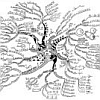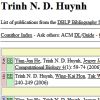| |
 
Leo van Iersel and
Steven Kelk. Constructing the Simplest Possible Phylogenetic Network from Triplets. In ALG, Vol. 60(2):207-235, 2011.
Keywords: explicit network, from triplets, galled tree, level k phylogenetic network, minimum number, phylogenetic network, phylogeny, polynomial, Program Marlon, Program Simplistic.
Note: http://dx.doi.org/10.1007/s00453-009-9333-0.
Toggle abstract
"A phylogenetic network is a directed acyclic graph that visualizes an evolutionary history containing so-called reticulations such as recombinations, hybridizations or lateral gene transfers. Here we consider the construction of a simplest possible phylogenetic network consistent with an input set T, where T contains at least one phylogenetic tree on three leaves (a triplet) for each combination of three taxa. To quantify the complexity of a network we consider both the total number of reticulations and the number of reticulations per biconnected component, called the level of the network. We give polynomial-time algorithms for constructing a level-1 respectively a level-2 network that contains a minimum number of reticulations and is consistent with T (if such a network exists). In addition, we show that if T is precisely equal to the set of triplets consistent with some network, then we can construct such a network with smallest possible level in time O(|T| k+1), if k is a fixed upper bound on the level of the network. © 2009 The Author(s)."
|
|
| |
    
Jean-Philippe Doyon,
Celine Scornavacca,
Konstantin Yu Gorbunov,
Gergely J. Szöllösi,
Vincent Ranwez and
Vincent Berry. An efficient algorithm for gene/species trees parsimonious reconciliation with losses, duplications, and transfers. In Proceedings of the Eighth RECOMB Comparative Genomics Satellite Workshop (RECOMB-CG'10), Vol. 6398:93-108 of LNCS, springer, 2011.
Keywords: branch length, duplication, dynamic programming, explicit network, from multilabeled tree, from species tree, from unrooted trees, lateral gene transfer, loss, phylogenetic network, phylogeny, polynomial, Program Mowgli, reconstruction.
Note: http://www.lirmm.fr/~vberry/Publis/MPR-DoyonEtAl.pdf, software available at http://www.atgc-montpellier.fr/MPR/.
Toggle abstract
"Tree reconciliation methods aim at estimating the evolutionary events that cause discrepancy between gene trees and species trees. We provide a discrete computational model that considers duplications, transfers and losses of genes. The model yields a fast and exact algorithm to infer time consistent and most parsimonious reconciliations. Then we study the conditions under which parsimony is able to accurately infer such events. Overall, it performs well even under realistic rates, transfers being in general less accurately recovered than duplications. An implementation is freely available at http://www.atgc- montpellier.fr/MPR. © 2010 Springer-Verlag."
|
|
| |
 
Leo van Iersel and
Steven Kelk. When two trees go to war. In JTB, Vol. 269(1):245-255, 2011.
Keywords: APX hard, explicit network, from clusters, from rooted trees, from sequences, from triplets, level k phylogenetic network, minimum number, NP complete, phylogenetic network, phylogeny, polynomial, reconstruction.
Note: http://arxiv.org/abs/1004.5332.
Toggle abstract
"Rooted phylogenetic networks are used to model non-treelike evolutionary histories. Such networks are often constructed by combining trees, clusters, triplets or characters into a single network that in some well-defined sense simultaneously represents them all. We review these four models and investigate how they are related. Motivated by the parsimony principle, one often aims to construct a network that contains as few reticulations (non-treelike evolutionary events) as possible. In general, the model chosen influences the minimum number of reticulation events required. However, when one obtains the input data from two binary (i.e. fully resolved) trees, we show that the minimum number of reticulations is independent of the model. The number of reticulations necessary to represent the trees, triplets, clusters (in the softwired sense) and characters (with unrestricted multiple crossover recombination) are all equal. Furthermore, we show that these results also hold when not the number of reticulations but the level of the constructed network is minimised. We use these unification results to settle several computational complexity questions that have been open in the field for some time. We also give explicit examples to show that already for data obtained from three binary trees the models begin to diverge. © 2010 Elsevier Ltd."
|
|
| |
  
Mukul S. Bansal,
J. Peter Gogarten and
Ron Shamir. Detecting Highways of Horizontal Gene Transfer. In Proceedings of the Eighth RECOMB Comparative Genomics Satellite Workshop (RECOMB-CG'10), Vol. 6398:109-120 of LNCS, springer, 2011.
Keywords: explicit network, from rooted trees, from species tree, lateral gene transfer, phylogenetic network, phylogeny, polynomial, reconstruction.
Note: http://www.cs.iastate.edu/~bansal/Highways_RCG10.pdf.
Toggle abstract
"In a horizontal gene transfer (HGT) event a gene is transferred between two species that do not share an ancestor-descendant relationship. Typically, no more than a few genes are horizontally transferred between any two species. However, several studies identified pairs of species between which many different genes were horizontally transferred. Such a pair is said to be linked by a highway of gene sharing. We present a method for inferring such highways. Our method is based on the fact that the evolutionary histories of horizontally transferred genes disagree with the corresponding species phylogeny. Specifically, given a set of gene trees and a trusted rooted species tree, each gene tree is first decomposed into its constituent quartet trees and the quartets that are inconsistent with the species tree are identified. Our method finds a pair of species such that a highway between them explains the largest (normalized) fraction of inconsistent quartets. For a problem on n species, our method requires O(n 4) time, which is optimal with respect to the quartets input size. An application of our method to a dataset of 1128 genes from 11 cyanobacterial species, as well as to simulated datasets, illustrates the efficacy of our method. © 2010 Springer-Verlag."
|
|
| |
 
Lavanya Kannan,
Hua Li and
Arcady Mushegian. A Polynomial-Time Algorithm Computing Lower and Upper Bounds of the Rooted Subtree Prune and Regraft Distance. In JCB, Vol. 18(5):743-757, 2011.
Keywords: bound, minimum number, polynomial, SPR distance.
Note: http://dx.doi.org/10.1089/cmb.2010.0045.
Toggle abstract
"Rooted, leaf-labeled trees are used in biology to represent hierarchical relationships of various entities, most notably the evolutionary history of molecules and organisms. Rooted Subtree Prune and Regraft (rSPR) operation is a tree rearrangement operation that is used to transform a tree into another tree that has the same set of leaf labels. The minimum number of rSPR operations that transform one tree into another is denoted by drSPR and gives a measure of dissimilarity between the trees, which can be used to compare trees obtained by different approaches, or, in the context of phylogenetic analysis, to detect horizontal gene transfer events by finding incongruences between trees of different evolving characters. The problem of computing the exact d rSPR measure is NP-hard, and most algorithms resort to finding sequences of rSPR operations that are sufficient for transforming one tree into another, thereby giving upper bound heuristics for the distance. In this article, we present an O(n4) recursive algorithm D-Clust that gives both lower bound and upper bound heuristics for the distance between trees with n shared leaves and also gives a sequence of operations that transforms one tree into another. Our experiments on simulated pairs of trees containing up to 100 leaves showed that the two bounds are almost equal for small distances, thereby giving the nearly-precise actual value, and that the upper bound tends to be close to the upper bounds given by other approaches for all pairs of trees. © Copyright 2011, Mary Ann Liebert, Inc. 2011."
|
|
| |
   
Mukul S. Bansal,
Guy Banay,
J. Peter Gogarten and
Ron Shamir. Detecting Highways of Horizontal Gene Transfer. In JCB, Vol. 18(9):1087-1114, 2011.
Keywords: explicit network, from rooted trees, from species tree, lateral gene transfer, phylogenetic network, phylogeny, polynomial, reconstruction.
Note: http://people.csail.mit.edu/mukul/HighwayFull_preprint.pdf.
Toggle abstract
"In a horizontal gene transfer (HGT) event, a gene is transferred between two species that do not have an ancestor-descendant relationship. Typically, no more than a few genes are horizontally transferred between any two species. However, several studies identified pairs of species between which many different genes were horizontally transferred. Such a pair is said to be linked by a highway of gene sharing. We present a method for inferring such highways. Our method is based on the fact that the evolutionary histories of horizontally transferred genes disagree with the corresponding species phylogeny. Specifically, given a set of gene trees and a trusted rooted species tree, each gene tree is first decomposed into its constituent quartet trees and the quartets that are inconsistent with the species tree are identified. Our method finds a pair of species such that a highway between them explains the largest (normalized) fraction of inconsistent quartets. For a problem on n species and m input quartet trees, we give an efficient O(m+n 2)-time algorithm for detecting highways, which is optimal with respect to the quartets input size. An application of our method to a dataset of 1128 genes from 11 cyanobacterial species, as well as to simulated datasets, illustrates the efficacy of our method. © 2011, Mary Ann Liebert, Inc."
|
|
| |
|
| |
   
Louxin Zhang,
Yen Kaow Ng,
Taoyang Wu and
Yu Zheng. Network model and efficient method for detecting relative duplications or horizontal gene transfers. In ICCABS11, Pages 214-219, 2011.
Keywords: dynamic programming, explicit network, from network, from rooted trees, from species tree, phylogenetic network, phylogeny, polynomial, reconstruction.
Toggle abstract
"Background: Horizontal gene transfer and gene duplication are two significant forces behind genome evolution. As more and more well-supported examples of HGTs are being revealed, there is a growing awareness that HGT is more widespread than previously thought, occurring often not only within bacteria, but also between species remotely related such as bacteria and plants or plants and animals. Although a substantial number of genomic sequences are known, HGT inference remains challenging. Parsimony-based inferences of HGT events are typically NP-hard under the framework of gene tree and species tree comparison; it is even more timeconsuming if the maximum likelihood approach is used. The fact that gene tree and species tree incongruence can be further confounded by gene duplication and gene loss events motivates us to incorporate considerations for these events into our inference of HGT events. Similarly, it will be beneficial if known HGT events are considered in the inference of gene duplications and gene losses. © 2011 IEEE."
|
|
|
 - forked on GitHub.
- forked on GitHub.






















































































































